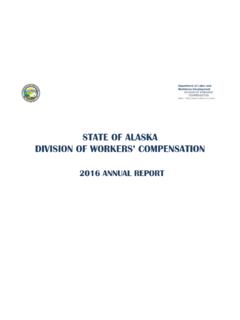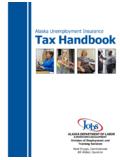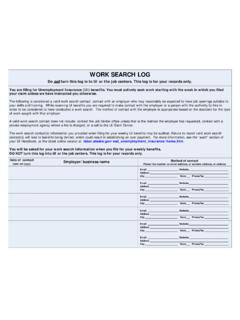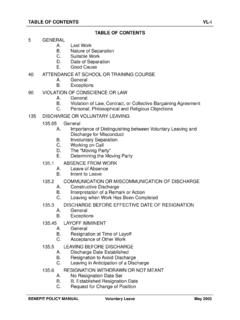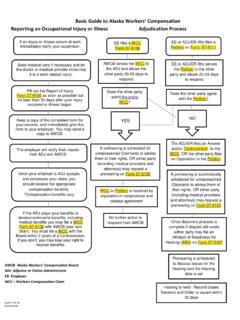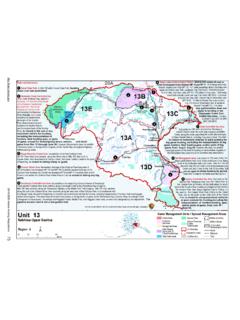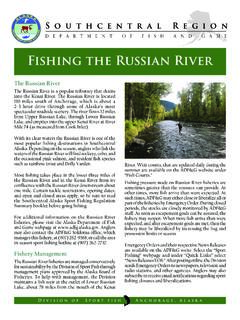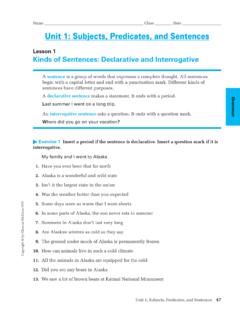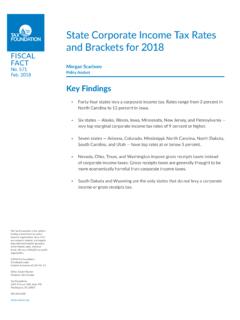Transcription of STATE OF ALASKA DEPARTMENT OF LABOR …
1 STATE OF ALASKA . DEPARTMENT OF LABOR . occupational safety AND HEALTH REVIEW BOARD. BOX 21149. JUNEAU, AK 99802. STATE OF ALASKA , DEPARTMENT ). OF LABOR , DIVISION OF LABOR ). STANDARDS AND safety , ). occupational safety AND ). HEALTH SECTION, ). ). Complainant, ) Docket No. 95-2054. ) Inspection No. 124074055. v. ). ). ALASKA BUILDING SYSTEMS, ). ). Contestant. ). _____ ). DECISION AND ORDER. ALASKA Building Systems (ABS) contests a citation issued by the STATE of ALASKA , DEPARTMENT of LABOR ( DEPARTMENT ) following an occupational safety and health inspection of ABS'.
2 Worksite in Soldotna, ALASKA on September 21, 1995. As a result of the inspection, the DEPARTMENT issued a citation to ABS alleging two violations of ALASKA occupational safety and health standards. Item 1a alleges a violation of Construction Code (CC) (b)(1)(D) for failing to install guardrails and toeboards around a scaffold more than six feet above the ground or floor. Item 1b alleges a violation of CC. (b)(1)(J) for failing to use appropriate scaffold grade planking. Items 1a and 1b were grouped into a single citation classified as "serious" with an assessed penalty of $175.
3 Pursuant to ABS' contest of the alleged violations, a hearing was held in Kenai on December 17, 1996. The DEPARTMENT was represented by Assistant Attorney General Tony N. Docket No. 95-2054 Page 1. Steinberger. ABS was represented by its owner, James McCool. The parties presented witness testimony, documentary evidence and oral argument. Upon review and consideration of the evidence and arguments of the parties, the Board makes the following findings of fact, conclusions of law and order in this matter.
4 FINDINGS OF FACT. 1. On September 21, 1995, DEPARTMENT enforcement officer Tim Bundy conducted an occupational safety and health inspection of a construction site at 34684 K Beach Road in Soldotna, ALASKA . 2. The construction site was a gas station which was being rebuilt after a fire. Bundy had previously driven by the site, noticed some scaffolding that did not appear proper, and obtained authorization to conduct a formal inspection. 3. ALASKA Building Systems was the primary construction contractor at the site.
5 ABS is a sole proprietorship owned by James McCool. McCool was not present at the site during the inspection. 4. During his inspection, Bundy observed a welded tubular scaffold with a wooden platform approximately 13 feet, 6 inches above the concrete floor of the building under construction. The platform was open-sided and did not have guardrails or toeboards. (Exs. 1 and 2.). 5. According to Bundy, the scaffold platform consisted of a sheet of plywood laid on top of three planks which he estimated as 2x6s.
6 Bundy did not see any grade stamp on the plywood platform or supporting planks indicating that they were scaffold grade material. For safety reasons Bundy did not climb the scaffold, and he did not closely examine the scaffold platform or measure its dimensions. 6. Bundy did not see any employees working on the scaffold during his inspection. However, he interviewed the ABS foreman who stated that two employees had been working on the platform to install cross-braces on the ceiling joists. This was corroborated by Bundy's interviews with Docket No.
7 95-2054 Page 2. the two employees. 7. ABS owner McCool acknowledged that his employees had access to the scaffold platform but stated that his foreman had told him that the platform was being used only for storage of materials. Neither the foreman nor the other employees testified at the hearing. 8. McCool conceded that the scaffold platform lacked guardrails and toeboards. He asserted, however, that the platform was built of materials equivalent to scaffold grade material and was strong enough to easily support the weight of two workers and their tools.
8 9. After Bundy's inspection, McCool directed his employees to take down and remove the scaffold, which they did. 10. Bundy classified the alleged violations as "serious" based on his conclusion that the hazard presented a greater rather than lesser probability of an accident, and that any resulting injury was likely to be at least moderately severe. 11. According to the DEPARTMENT 's penalty calculation procedures, a serious violation of greater probability and medium severity carries an unadjusted penalty of $3,500.
9 ABS'. unadjusted penalty was reduced 60% for company size, 25% for good faith, and 10% for no history of prior violations, resulting in an assessed penalty of $175. (Ex. 3.). CONCLUSIONS OF LAW. Item 1a Construction Code (b)(1)(D) provides: Guardrails and toeboards shall be installed on all open sides and ends of platforms more than six feet above the ground or floor, except needle beam scaffolds and floats. Scaffolds four feet to six feet in height, having a minimum of horizontal dimension in either direction of less than 45 inches, shall have standard guardrails installed on all open sides and ends of the platform.
10 The evidence clearly demonstrates, and ABS does not controvert, that the scaffold in Docket No. 95-2054 Page 3. question was over six feet high and did not have the required guardrails and toeboards. Nevertheless, ABS argues that the DEPARTMENT did not adequately establish employee exposure to the hazard, based on the inspector's failure to personally observe employees working on the scaffold. This argument is without merit. Employee exposure need not be established through direct personal observation by the inspector, but may be proved through other evidence.
